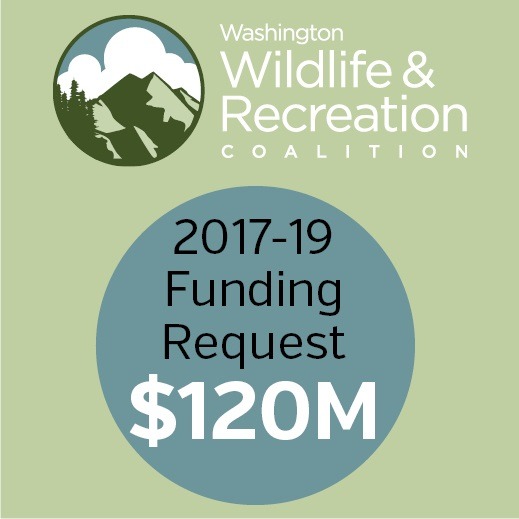
The RCFB-approved $120 million funding request will account for growing recreation and conservation needs in Washington state.
The Recreation & Conservation Funding Board (RCFB) unanimously approved a $120 million funding request for the WWRP to be included in the RCO’s budget request to the Governor. The RCFB’s decision mirrors what the Coalition’s Board of Directors had also unanimously resolved to advocate for next session.
The Coalition developed the $120 million funding request through a deliberative process, taking into consideration several indicators of WWRP Program needs.
The five indicators (detailed in this handout) are:
- Indicator 1: Original funding level ($53 million) adjusted for inflation.
- Indicator 2:
Appropriation requests as a percentage (4.3%) of total bond funding capacity.
- Indicator 3: Appropriation requests adjusted for rising construction costs using the construction cost index (CCI), which has risen at an annual average of 8.5.
- Indicator 4: Appropriation requests adjusted for increasing state REET collections (with an average annual linear rate increase of about $20 million).
- Indicator 5: Appropriation requests per capita, adjusted for 2016 dollars (with an estimated state population of 7.5 million and $18.94 per resident).
There are a plethora of reasons why WWRP funding is crucial for the health, happiness, and unity of our communities. First and foremost, the program helps preserve and create new spaces for communities to gather, play, learn, and build relationships – things that are more important than ever in today’s increasingly fractured society.
The WWRP is also uniquely suited to help bridge the economic disparity between urban and rural areas of the state, by helping small communities draw tourism from urban centers.
The $120 million request will account for our State’s growing recreation and conservation funding needs. The WWRP is the largest source of funding for habitat conservation, outdoor recreation, and working lands preservation. In 2016, the program was updated to address concerns from lawmakers and better reflect the current needs of our state. The updates include:
- a simplified allocation formula;
- increased public access statewide;
- the addition of a small forest category for allowable working lands;
- land trusts eligibility in more habitat conservation categories;
- recognition of the development needs in state and local parks, as well as increased stewardship on WWRP sites; and,
- more opportunities for economically disadvantaged communities to apply for program funding.
